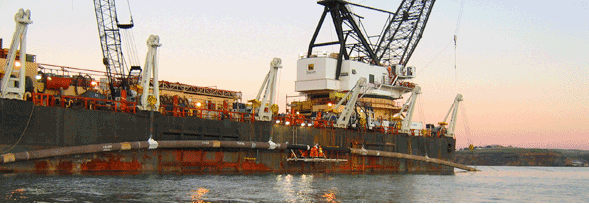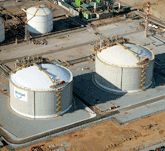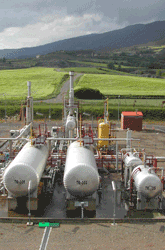Gas in Spain
>
Investment and company activity
>
Some of the most notable features of 2008.
Some of the most notable features of 2008.
Returning to the issue of connection with France, at the beginning of February 2009, Naturgas Energía announced that it had begun work on the first stage of the Vergara-Irun gas pipeline, which would have a diameter of 26 inches as opposed to the 16-inch gauge of the old pipeline. As well as representing an important advance as regards guaranteeing the supply to Guipuzcoa (an additional gas channel and enhanced carrier capacity), this forms the second part of the Euskadour pipeline, which connects Naturgas Energía’s networks with those of the TIGF (Total Infrastructures Gaz France) in south-western France. It should be recalled that the Euskadour gas pipeline will, when completed, become an important channel for the transportation of gas in both directions, alleviating the insufficient capacity offered by the current connections between the Iberian Peninsular and the countries to the north of the Pyrenees, as already mentioned.
Naturgas Energía Transporte has also completed and opened the gas pipeline to the combined-cycle plant in Soto de Ribera, which operates at a pressure of 80 bar.
Within this same corporate group, Naturgas Energía Distribución introduced a gas supply network in five new towns and cities in 2008, beginning work in a further five. Last year it acquired all the shares in Gas Mérida, a company that distributes natural gas in the Extremaduran capital.
Bahía de Bizkaia Gas, owner of the unloading and regasification terminal located in the outskirts of Bilbao took deliveries from a total of 67 vessels in 2008, providing a total supply of 56.4 TWh.
Gas Natural remained very active during the course of 2008. The following is just a brief selection of some of its many projects:
Natural gas and LPG are energy sources that give off fewer polluting gases during the combustion process than any other hydrocarbon fuel source. It is clear that their use in the transport sector represents an effective action against the emission of greenhouse gases and pollutants that are harmful to human health.
Turning to Iberdrola and its gas distribution business, in 2008 the government of the Community of Valencia gave priority gasification project status to the proposals submitted by Iberdrola Distribución de Gas for Marina Baja county in Alicante and the Alto Palencia region in Castellón.
Within the natural gas sector, Iberdrola, S.A. is active in the areas of supply, logistics, trading and delivery to end customers. In 2008, Iberdrola managed 6.9 bcm of natural gas, 19% more than the previous year. The company ended the year with a portfolio of long-term supply contracts totalling more than 18.5 bcm per year, covering its supply requirements in Spain, the united Kingdom, Mexico and Brazil. The company is also active in the markets in France, Germany and Austria, where it sells natural gas either directly to the end user or for use in the generation of electricity.
In 2008, Iberdrola managed 100 consignments of LNG at terminals around Spain and in other countries. The LNG itself came from seven different countries, including Norway. Iberdrola was the first Spanish company to order Norwegian LNG and bring it to Spain. Iberdrola also obtained a commercial licence during 2008 to trade in the natural gas market in Portugal.
During 2008, Endesa Energía strengthened its position as the second largest retailer of natural gas to end customers in Spain, singularly energising competition in a liberalised market place.
July 2008 saw completion of the corporate operation involving the merger of Gaz de France Group and Suez Group. GDF SUEZ Comercializadora, formerly Gaz de France Comercializadora, sells natural gas, electricity and energy services to industrial clients in Spain, while the GDF SUEZ Group has a strong commercial presence in a number of European countries.
EGL España (a subsidiary of Elektrizitäts-Gesellschft Laufenburg) obtained a licence to market gas in Spain in September 2007 and began supplying customers during 2008. Its target market includes large industrial customers and cogeneration plants.
By the end of 2008, Medgaz, the company building the underwater gas pipeline between Beni Saf (Algeria) and Almeria (Spain), had completed laying the pipeline on the seabed. It is expected to enter operation during the second half of 2009. It should be recalled that the 24” pipeline, which lies at a maximum depth of 2,160 metres, will have an annual capacity of 8 bcm. Cepsa is the main driving force behind this project.
At the Algerian end, this facility will be connected to the Hassi R’Mel-Beni Saf pipeline, managed by Sonatrach, while in Spain it will meet the Almería-Albacete pipeline owned by Enagás.
Enagás is also building the Denia-Ibiza-Mallorca gas pipeline, and at the end of November 2008 it began work on laying the pipes from the Ibizan town of Sant Antoni de Portmany. The underwater section of this gas pipeline will cover 268 km and will cost 360 million euros. Total investment for the project totals 490 million euros and, in addition to the underwater pipeline, will include the Montesa-Denia gas pipeline and a compressor station.
The supply of gas to the electrical plants on the two islands involved in the project will reduce CO2 emissions by 40%.
Centrica Energía was formed in Spain in 2002 as a subsidiary of Centrica plc. In 2006 it began to supply natural gas to cogeneration plants, and it currently offers a broad range of energy management services for generators using renewables and cogeneration techniques. It has also developed energy consultancy services.
During 2008 Unión Fenosa Comercial continued to expand its sale of natural gas to residential, commercial and light-industry customers, growing its business by around 30% in comparison with the previous year. It offers all of its customers a broad range of products and complementary added value services in both energy-related and non-energy-related areas.
Technical work and action in the underground storage sector has continued as scheduled. One example is the creation of the Castor marine storage facility 21 km off the coast of Vinaroz (Castellón), on which work is to begin in spring 2010. The latest estimate is that gas could begin being injected into the cavities of this old underground oil field by summer 2012.

Naturgas Energía Transporte has also completed and opened the gas pipeline to the combined-cycle plant in Soto de Ribera, which operates at a pressure of 80 bar.
Within this same corporate group, Naturgas Energía Distribución introduced a gas supply network in five new towns and cities in 2008, beginning work in a further five. Last year it acquired all the shares in Gas Mérida, a company that distributes natural gas in the Extremaduran capital.
During 2008, Enagás invested more than it had in 2007, reaching figures not seen before in the company’s history. By the end of the year, Enagás had infrastructure projects under construction worth around 1 billion euros. Some of the most important projects introduced in 2008 were:
- The Alcázar de San Juan-Montesa cross-link, which connects two important lines: the one that runs along the east of the Peninsular and the north-south line.
- The entry into operation of the fourth LNG storage tank (150,000 m3) at the Cartagena terminal, and the increase in the terminal’s supply capacity from 1.2 million to 1.35 million m3 per hour.
- The Madrid southeast half-ring.
- Enlargement of the BBV gas pipeline, Arbós - Barcelona Plant section.
- Montesa-Denia gas pipeline.
- Compressor stations at Zaragoza and Alcázar de San Juan.
- Branch line to Campo de Gibraltar. Phase II.
Other notable infrastructure items that were brought into service by other companies during 2008 included:
- Endesa’s Arévalo-Medina del Campo gas pipeline.
- The southern gas pipeline, section I, Cabanas-Betanzos-Abegondo, which has been developed by Reganosa, the owner of the plant at Mugardos, close to Ferrol.
- Increased supply capacity at the Sagunto terminal, to 1 million m3 (n)/h.
Bahía de Bizkaia Gas, owner of the unloading and regasification terminal located in the outskirts of Bilbao took deliveries from a total of 67 vessels in 2008, providing a total supply of 56.4 TWh.
Gas Natural remained very active during the course of 2008. The following is just a brief selection of some of its many projects:
- A collaborative agreement was signed with the government of the Autonomous Community of Madrid for the development of a new plan to replace the Community’s coal-fired furnaces. It currently operates some 1,200 furnaces that are fuelled by coal.
- In February, the company announced that it had obtained a licence to sell natural gas on the Portuguese market.
- Several agreements were signed during the course of the year to encourage the use of natural gas in Spain as a fuel for light vehicles.
- An agreement was signed with a leading company in the heating and hot-water production sector, aimed at provided support and development for micro cogeneration in Spain.
- The company announced the award of 1,209 GWh in the first tender for underground natural gas storage capacity to take place in Spain.
- The company obtained a favourable environmental report for the regasification plant being developed by Gas Natural in Trieste (Italy). Staying in Italy, in the middle of the year, it acquired the gas distribution group Pitta Costruzioni, which operates in the Puglia region.
- On 30 July, Gas Natural gave notice to the CNE regarding the signing of an agreement to purchase 45.3% of the shares in Unión Fenosa.
- Agreements have been signed with the governments of several autonomous communities with a view to enlarging the natural gas service within their individual territories.
- This process formed the backdrop for the development of several gas pipelines during the course of the year, such as the Súria-Cardona-Solsona pipeline connecting the provinces of Barcelona and Lleida.
- A great amount of educational work was carried out among both specialists and the public at large. Organised by the Gas Natural Foundation, it offered information on the properties of natural gas and the ways it can be used to complement other forms of energy, particularly renewables.
- Gas Natural Servicios has become the largest last-resort supplier based on the number of customers, following the disappearance of the regulated market on 30 June 2008.
Natural gas and LPG are energy sources that give off fewer polluting gases during the combustion process than any other hydrocarbon fuel source. It is clear that their use in the transport sector represents an effective action against the emission of greenhouse gases and pollutants that are harmful to human health.
Turning to Iberdrola and its gas distribution business, in 2008 the government of the Community of Valencia gave priority gasification project status to the proposals submitted by Iberdrola Distribución de Gas for Marina Baja county in Alicante and the Alto Palencia region in Castellón.
Within the natural gas sector, Iberdrola, S.A. is active in the areas of supply, logistics, trading and delivery to end customers. In 2008, Iberdrola managed 6.9 bcm of natural gas, 19% more than the previous year. The company ended the year with a portfolio of long-term supply contracts totalling more than 18.5 bcm per year, covering its supply requirements in Spain, the united Kingdom, Mexico and Brazil. The company is also active in the markets in France, Germany and Austria, where it sells natural gas either directly to the end user or for use in the generation of electricity.
In 2008, Iberdrola managed 100 consignments of LNG at terminals around Spain and in other countries. The LNG itself came from seven different countries, including Norway. Iberdrola was the first Spanish company to order Norwegian LNG and bring it to Spain. Iberdrola also obtained a commercial licence during 2008 to trade in the natural gas market in Portugal.
During 2008, Endesa Energía strengthened its position as the second largest retailer of natural gas to end customers in Spain, singularly energising competition in a liberalised market place.
July 2008 saw completion of the corporate operation involving the merger of Gaz de France Group and Suez Group. GDF SUEZ Comercializadora, formerly Gaz de France Comercializadora, sells natural gas, electricity and energy services to industrial clients in Spain, while the GDF SUEZ Group has a strong commercial presence in a number of European countries.
EGL España (a subsidiary of Elektrizitäts-Gesellschft Laufenburg) obtained a licence to market gas in Spain in September 2007 and began supplying customers during 2008. Its target market includes large industrial customers and cogeneration plants.
By the end of 2008, Medgaz, the company building the underwater gas pipeline between Beni Saf (Algeria) and Almeria (Spain), had completed laying the pipeline on the seabed. It is expected to enter operation during the second half of 2009. It should be recalled that the 24” pipeline, which lies at a maximum depth of 2,160 metres, will have an annual capacity of 8 bcm. Cepsa is the main driving force behind this project.
At the Algerian end, this facility will be connected to the Hassi R’Mel-Beni Saf pipeline, managed by Sonatrach, while in Spain it will meet the Almería-Albacete pipeline owned by Enagás.
Enagás is also building the Denia-Ibiza-Mallorca gas pipeline, and at the end of November 2008 it began work on laying the pipes from the Ibizan town of Sant Antoni de Portmany. The underwater section of this gas pipeline will cover 268 km and will cost 360 million euros. Total investment for the project totals 490 million euros and, in addition to the underwater pipeline, will include the Montesa-Denia gas pipeline and a compressor station.
The supply of gas to the electrical plants on the two islands involved in the project will reduce CO2 emissions by 40%.
Centrica Energía was formed in Spain in 2002 as a subsidiary of Centrica plc. In 2006 it began to supply natural gas to cogeneration plants, and it currently offers a broad range of energy management services for generators using renewables and cogeneration techniques. It has also developed energy consultancy services.
During 2008 Unión Fenosa Comercial continued to expand its sale of natural gas to residential, commercial and light-industry customers, growing its business by around 30% in comparison with the previous year. It offers all of its customers a broad range of products and complementary added value services in both energy-related and non-energy-related areas.
Technical work and action in the underground storage sector has continued as scheduled. One example is the creation of the Castor marine storage facility 21 km off the coast of Vinaroz (Castellón), on which work is to begin in spring 2010. The latest estimate is that gas could begin being injected into the cavities of this old underground oil field by summer 2012.
It should be remembered that Enagás also obtained administrative consent to operate a storage facility at Yela, in Guadalajara, which represents one of the most important investment projects in the coming years and a further step towards increasing the security of the Spanish gas system.
NUMBER OF PEOPLE EMPLOYED BY COMPANIES IN THE NATURAL GAS SECTOR
YEARS
- EMPLOYEES
1995
- 4.157
2000
- 4.371
2001
- 4.424
2002
- 4.511
2003
- 4.765
2004
- 5.419
2005
- 5.773
2006
- 5.916
2007
- 6.099
2008
- 6.171

Medgaz

-
 Enagás
Enagás -
 Enagás
Enagás
Annual Report 2.008: Sedigas - The Spanish Gas Association

